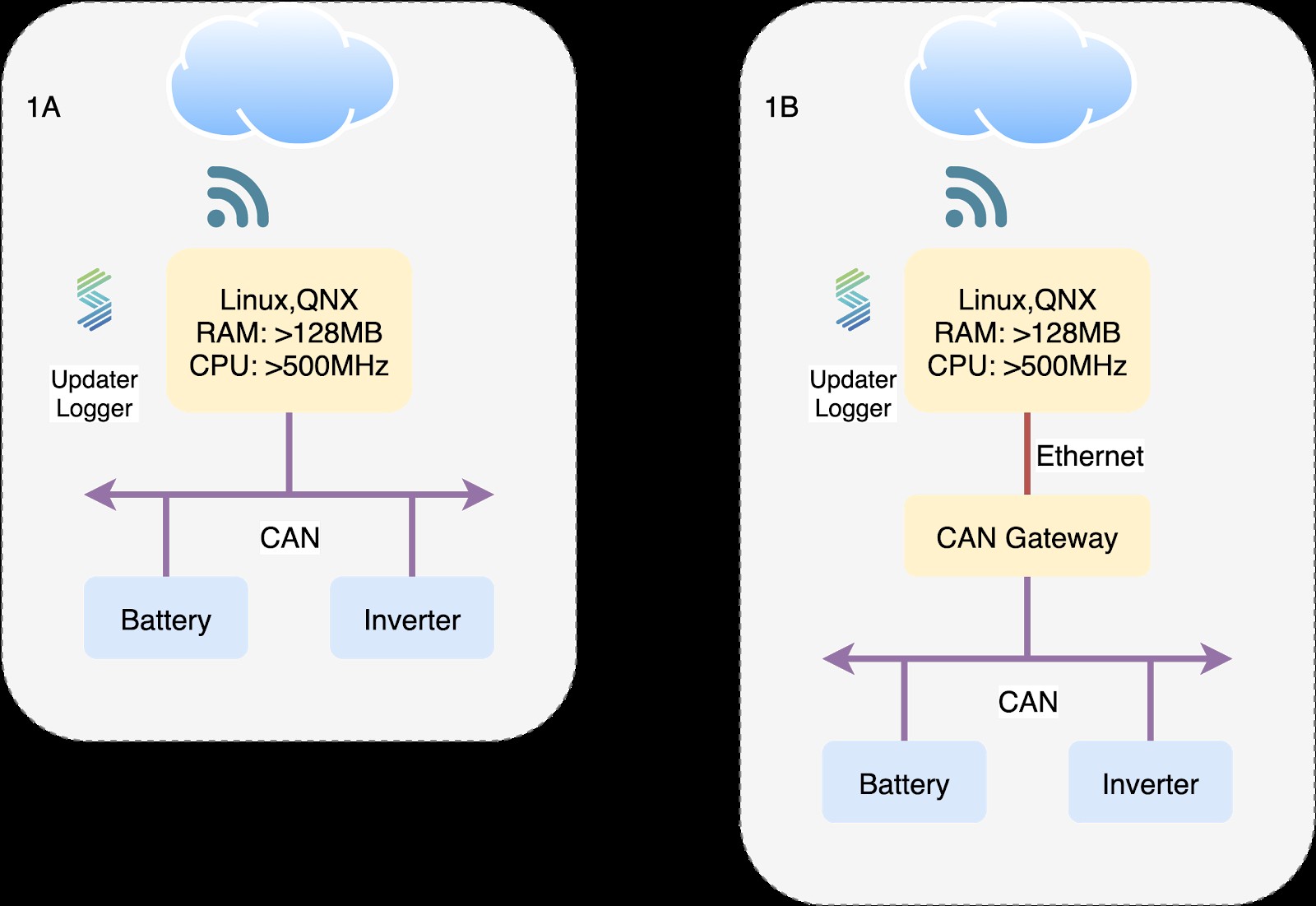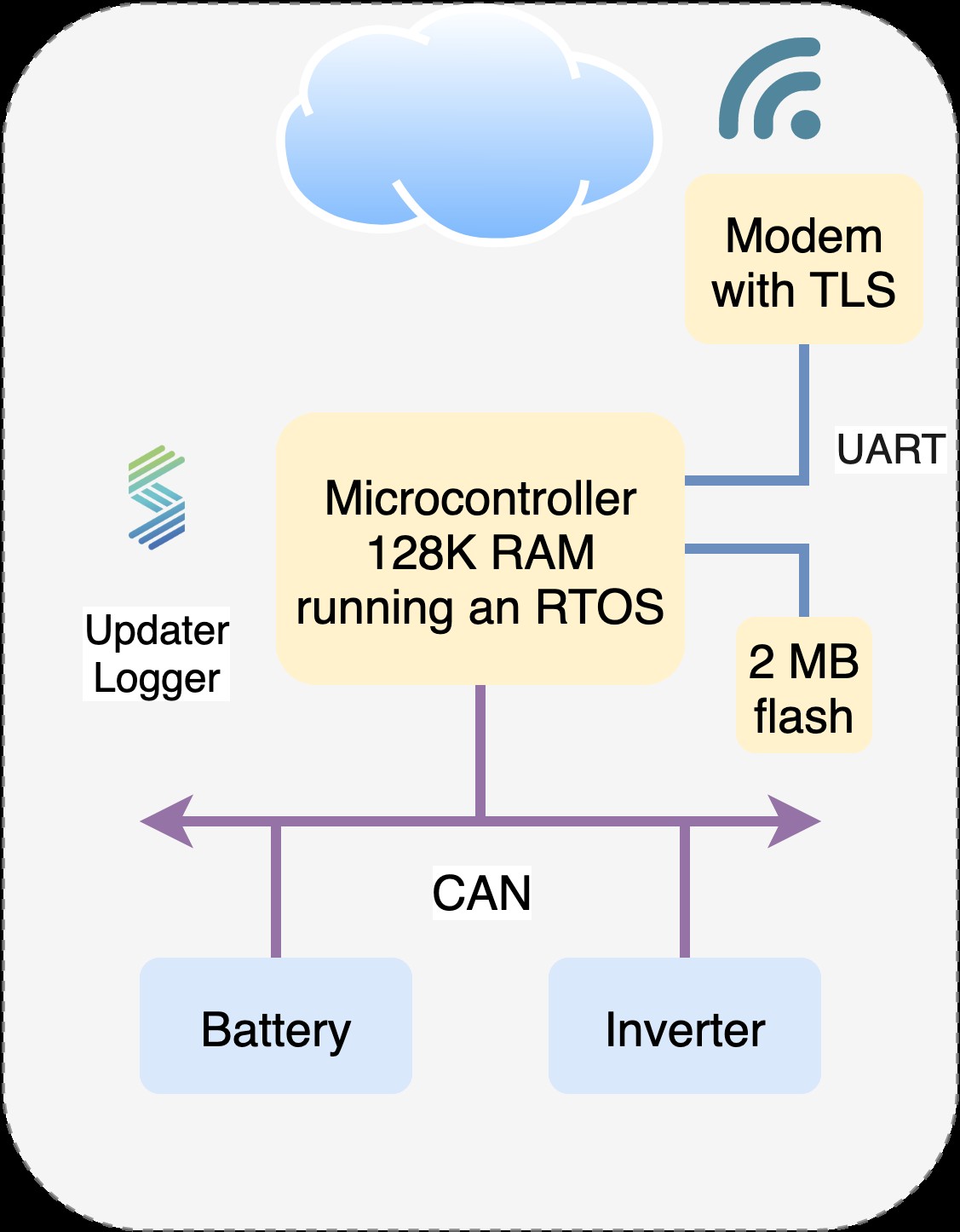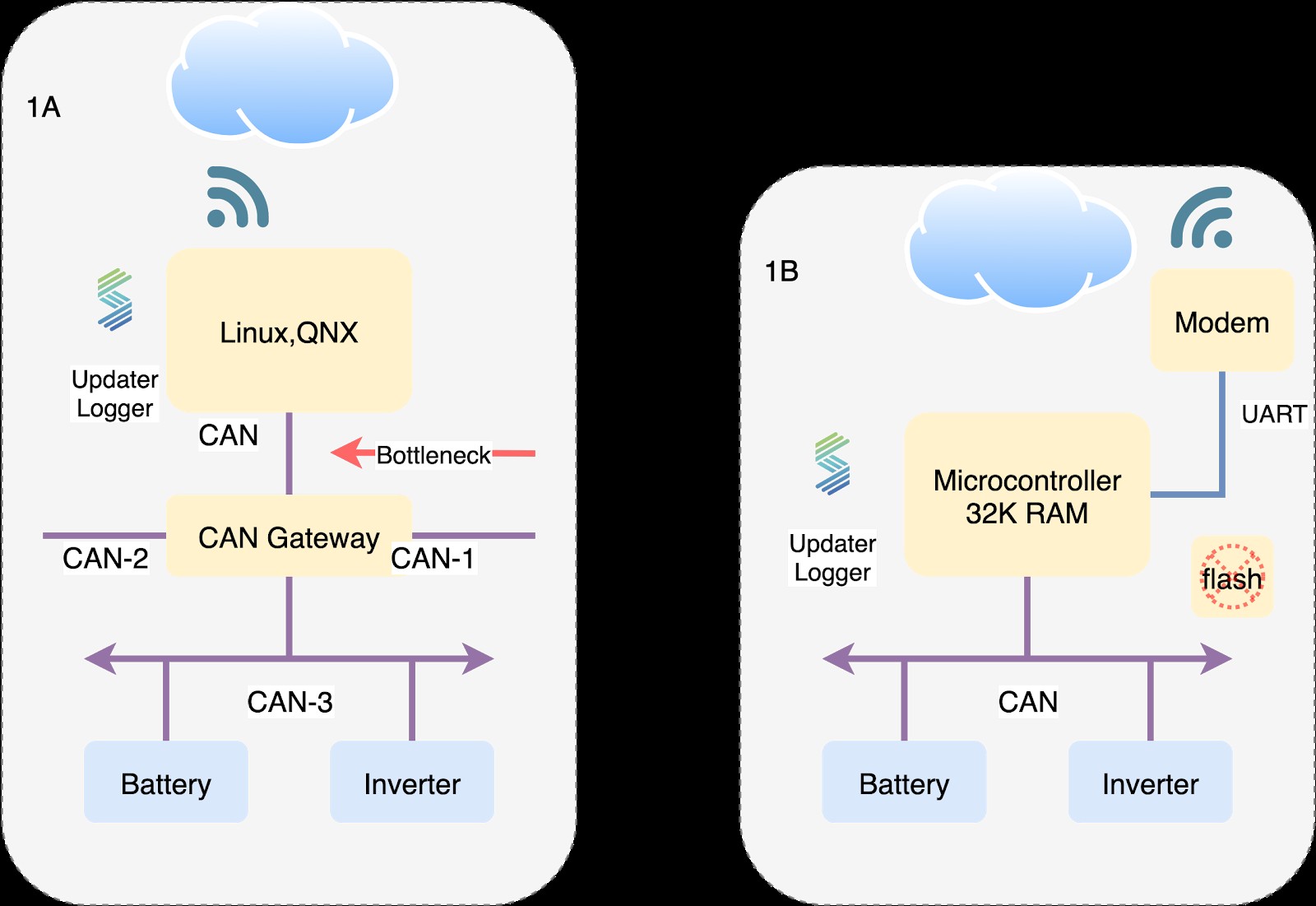Connected Car Software Architecture is the backbone of modern automotive innovation, allowing for over-the-air (OTA) updates, data logging, and enhanced vehicle functionality. At CAR-REMOTE-REPAIR.EDU.VN, we help you understand and implement these architectures to keep your skills sharp and your garage competitive. Dive in to learn how the right architecture can revolutionize vehicle performance, security, and the overall driving experience, plus, find out how our training programs can give you a head start in this rapidly evolving field.
Contents
- 1. Understanding Connected Car Software Architecture
- 2. Why Connected Car Software Architecture Matters
- 3. Key Components of Connected Car Software Architecture
- 4. Types of Connected Car Software Architectures
- 5. POSIX Architecture Explained
- 6. Microcontroller Architecture: A Closer Look
- 7. Architectures to Avoid in Connected Cars
- 8. Security Considerations in Connected Car Architecture
- 9. The Future of Connected Car Software Architecture
- 10. How CAR-REMOTE-REPAIR.EDU.VN Can Help You
- FAQ: Connected Car Software Architecture
1. Understanding Connected Car Software Architecture
What exactly is connected car software architecture?
Connected car software architecture refers to the design and structure of software systems within a vehicle that enables communication, data exchange, and functionality updates. It’s the blueprint that dictates how different software components interact to deliver services like over-the-air (OTA) updates, diagnostics, infotainment, and advanced driver-assistance systems (ADAS). This architecture is crucial for modern vehicles as it supports continuous improvement, feature enhancements, and security updates throughout the vehicle’s lifecycle.
The architecture involves several key elements:
- Central Processing Unit (CPU): The brain of the system, executing instructions and managing operations.
- Operating System (OS): Software that manages hardware and software resources, providing a platform for applications.
- Middleware: Software that facilitates communication and data management between different components.
- Communication Interfaces: Protocols and hardware (e.g., CAN, Ethernet) that allow various ECUs and systems to interact.
- Security Framework: Mechanisms to protect the system from cyber threats and unauthorized access.
- Application Layer: Software applications providing specific functionalities, such as navigation, media, and vehicle diagnostics.
These components work together to create a robust and scalable system that can handle the complexities of modern vehicle operation. The selection of a specific architecture depends on the vehicle’s intended use, performance requirements, and cost considerations.
2. Why Connected Car Software Architecture Matters
Why is connected car software architecture so critical in today’s automotive industry?
Connected car software architecture is vital because it enables vehicles to evolve and adapt throughout their lifespan. With a robust architecture, automakers can deliver over-the-air (OTA) updates to fix bugs, improve performance, and introduce new features without requiring physical visits to a service center. This capability enhances customer satisfaction and reduces the costs associated with traditional recalls.
Moreover, a well-designed architecture supports advanced functionalities such as:
- Real-time diagnostics: Monitoring vehicle health and predicting potential issues.
- Data-driven insights: Collecting and analyzing vehicle data to improve future designs and services.
- Enhanced safety features: Implementing and updating ADAS to prevent accidents.
- Personalized driving experience: Tailoring vehicle settings and features to individual preferences.
According to research from McKinsey, connected car services are expected to generate up to $750 billion in revenue by 2030, highlighting the significant economic impact of this technology. Effective software architecture is the foundation for realizing this potential, enabling automakers to create new revenue streams and stay competitive in a rapidly evolving market.
3. Key Components of Connected Car Software Architecture
What are the essential components that make up a connected car software architecture?
The key components of a connected car software architecture include the Central Processing Unit (CPU), Operating System (OS), Middleware, Communication Interfaces, Security Framework, and Application Layer. Each component plays a crucial role in enabling the vehicle to communicate, process data, and deliver advanced functionalities.
- Central Processing Unit (CPU): Serves as the brain of the system, responsible for executing instructions, managing operations, and coordinating the activities of other components. Modern connected cars often use high-performance CPUs to handle complex tasks such as processing sensor data, running AI algorithms, and managing communication.
- Operating System (OS): Provides a platform for software applications to run and manages hardware and software resources. Common operating systems for connected cars include Linux, QNX, and Android Automotive, each offering different features and capabilities.
- Middleware: Facilitates communication and data management between different software components and systems. It acts as an intermediary, allowing various applications and services to interact seamlessly, regardless of their underlying technology.
- Communication Interfaces: Enable the exchange of data between different ECUs (Electronic Control Units) within the vehicle and external networks. Common interfaces include CAN (Controller Area Network), Ethernet, and wireless technologies like Bluetooth, Wi-Fi, and cellular.
- Security Framework: Protects the system from cyber threats and unauthorized access. It includes measures such as encryption, authentication, and intrusion detection to ensure the integrity and confidentiality of data.
- Application Layer: Consists of software applications that provide specific functionalities, such as navigation, media, vehicle diagnostics, and ADAS. These applications leverage the underlying architecture to deliver value to the driver and passengers.
4. Types of Connected Car Software Architectures
What are the different types of software architectures used in connected cars?
Different types of software architectures used in connected cars include POSIX, Microcontroller, and Domain-Specific Architectures. Each architecture has its strengths and weaknesses, making them suitable for different vehicle types and applications.
- POSIX Architecture: Employs a Linux, QNX, or similar operating system with OS-provided services for file system and networking through BSD sockets API. This architecture is commonly used in electric cars, buses, and vehicles with infotainment UI screens due to its robust capabilities.
- Microcontroller Architecture: Utilizes a microcontroller running an RTOS (Real-Time Operating System) like FreeRTOS. It is often found in scooters, two-wheelers, and cost-sensitive IoT devices due to its optimized power consumption and lower hardware costs.
- Domain-Specific Architectures: Tailored for specific functionalities or domains within the vehicle. Examples include architectures for ADAS, infotainment, and powertrain control, each optimized for the unique requirements of their respective domains.
Choosing the right architecture depends on various factors such as the vehicle’s intended use, performance requirements, cost considerations, and security needs. Understanding the characteristics of each architecture is essential for designing a connected car system that meets the desired objectives.
5. POSIX Architecture Explained
Can you explain more about POSIX architecture and its benefits?
A POSIX architecture implies a Linux, QNX, or equivalent operating system that has OS-provided services for file system and networking through BSD sockets API. This architecture generally has applications in electric cars and buses, and vehicles with infotainment UI screens.
 Example POSIX architecture
Example POSIX architecture
POSIX architecture example using NXP S32G, 1GHz ARM with 1 GB of RAM, and built-in CAN peripherals.
Typically, this system would contain tens of megabytes of RAM and a GHz-scale processor, such as a 1GHz ARM processor. With a POSIX architecture, networking stack or TLS security stack are provided by the OS, making writing software applications on top of this POSIX OS much more simplified.
In this architecture, the POSIX operating system provides access to the Internet (with on-board LTE modem and Wifi) and is also connected to any downstream controllers directly through CAN or another high-speed CAN gateway.
Benefits of POSIX Architecture:
- Security: Easier to implement on a POSIX system (TLS managed by the OS).
- Development: Applications are easier to develop with standard interface to network stack (BSD sockets).
- Robustness: If one application crashes (such as infotainment), it will not affect the ability to provide future bug fixes through OTA updates.
Example Hardware:
- NXP S32G
- 1GHz ARM with 1 Gigabytes of RAM
- Built-in CAN peripherals or CAN bus access through a CAN Gateway through Ethernet backbone
6. Microcontroller Architecture: A Closer Look
What are the specifics and advantages of using a microcontroller architecture?
In a microcontroller architecture, a microcontroller running an RTOS (such as FreeRTOS) is connected to the Internet via a modem. The applications for this architecture are most commonly scooters or 2 wheelers, or cost-sensitive IoT devices.
 Example Microcontroller Architecture
Example Microcontroller Architecture
Microcontroller architecture example using ARM Cortex (M0, M3, M4 etc.) with minimum 128K RAM, 512K ROM, and external interface to at least 2 Megabytes of flash.
This architecture has its advantages, such as optimized power consumption, lower hardware cost, and faster bootup when compared to a POSIX operating system. It is also cost effective because it does not require a POSIX operating system.
However, there is a hidden cost of supporting a microcontroller that may need to run a complex software stack. Integrating a TLS library on a microcontroller requires a measurable amount of software integration effort, whereas in a Linux-like environment, such a facility is provided in the operating system itself. Also, the interface to the modem is non-standard, requiring additional engineering effort, limiting the interface and making supporting multiple IP connections difficult.
CPU computing power is usually not a limitation with this architecture, but in order to comfortably support on-board TLS security, data logging, and firmware update stack, a minimum of 128K of RAM is highly recommended. External flash storage of 2 megabytes is recommended assuming modest requirement of supporting OTA update of 2 controllers with 512K hex file size.
Benefits of Microcontroller Architecture:
- Cost-Effective: Hardware cost is low, and RTOS like FreeRTOS is also free.
- Low Power Consumption: Hardware can be in ON/Active state to provide quick power-up operation to the end user (such as customer opening a car door).
Example Hardware:
- ARM Cortex (M0, M3, M4 etc.)
- Minimum 128K RAM, 512K ROM
- External interface to at least 2 Megabytes of flash
7. Architectures to Avoid in Connected Cars
Which software architectures should be avoided in connected car designs?
Certain architectures should be avoided in connected car designs due to potential bottlenecks and limitations in performance, security, and storage. These include architectures with gated CAN buses and microcontrollers with limited RAM and storage.
 Architectures not recommended
Architectures not recommended
Not recommended architectures featuring gated CAN buses and microcontrollers with limited resources.
In architecture 1A, there is a bottleneck in the system because multiple CAN buses are designed to be gated through another CAN bus. In such a system, if there are heavily loaded CAN buses, then squeezing all of their traffic through another CAN bus is not feasible. Excessive software development would be needed in order to prevent the bottleneck, and the system could still result in compromises.
In architecture 1B, a modem is connected to a microcontroller with a limited amount of RAM. It would be extremely difficult to run any form of data logging and firmware upgrade stack with limited amounts of RAM. A typical RAM requirement is 20K of RAM for data logging and software upgrade stack, and with this limit of 36K of RAM, there is little RAM to run the rest of the customer application. Another issue that arises with storage constraints is the lack of ability to secure the hardware from internet attacks. Adding TLS to a microcontroller would require at least 20 kilobytes of RAM, and it is recommended to have at least 128 KB of RAM on the microcontroller to account for TLS security, Updater stack, Logging stack, and customer applications.
A second challenge in architecture 1B is that it does not have any non-volatile storage to be able to store the firmware update artifacts (hex files of other controllers). In order to perform security and signature verification, the entire image would need to be downloaded to a storage medium.
In summary, storage, performance, cost, and security are among just some of the key attributes to consider when selecting a connected vehicle platform architecture.
8. Security Considerations in Connected Car Architecture
How does security play a role in connected car software architecture?
Security is a paramount consideration in connected car software architecture, given the potential risks associated with cyberattacks. A robust security framework is essential to protect the vehicle’s systems and data from unauthorized access, manipulation, and theft.
Key security measures include:
- Encryption: Protecting data in transit and at rest using cryptographic algorithms.
- Authentication: Verifying the identity of users and devices attempting to access the system.
- Intrusion Detection and Prevention: Monitoring the system for suspicious activity and blocking potential attacks.
- Secure Boot: Ensuring that only authorized software is loaded during the vehicle’s startup process.
- Firewalls: Controlling network traffic and preventing unauthorized access to critical systems.
- Over-the-Air (OTA) Security: Securing the OTA update process to prevent malicious software from being installed.
According to a report by the National Highway Traffic Safety Administration (NHTSA), cyberattacks on vehicles are increasing, highlighting the need for robust security measures in connected car architecture. By implementing these measures, automakers can mitigate the risks and ensure the safety and security of their vehicles.
9. The Future of Connected Car Software Architecture
What trends and advancements are shaping the future of connected car software architecture?
Several trends and advancements are shaping the future of connected car software architecture, including the rise of software-defined vehicles, the increasing use of AI and machine learning, and the adoption of cloud-native technologies. These trends are driving the evolution of connected car systems, enabling new functionalities and improving the overall driving experience.
- Software-Defined Vehicles (SDVs): SDVs are vehicles where software plays a dominant role in defining their features and capabilities. This trend is driving the need for more flexible and scalable software architectures that can be easily updated and customized.
- Artificial Intelligence (AI) and Machine Learning (ML): AI and ML are being increasingly used in connected cars for applications such as ADAS, predictive maintenance, and personalized services. These technologies require robust software architectures that can handle large amounts of data and complex algorithms.
- Cloud-Native Technologies: Cloud-native technologies, such as containerization and microservices, are being adopted to improve the scalability, reliability, and maintainability of connected car systems. These technologies enable automakers to deploy and update software more quickly and efficiently.
- 5G Connectivity: The rollout of 5G networks is enabling faster and more reliable communication between vehicles and the cloud, opening up new possibilities for connected car services and applications.
- Cybersecurity Advancements: As cyber threats become more sophisticated, there is a growing focus on developing more robust security measures for connected car systems. This includes the use of advanced encryption techniques, intrusion detection systems, and secure OTA update mechanisms.
According to a report by Gartner, the market for automotive software and electronics will reach $240 billion by 2025, highlighting the significant growth potential in this area. By embracing these trends and advancements, automakers can create innovative connected car systems that meet the evolving needs of drivers and passengers.
10. How CAR-REMOTE-REPAIR.EDU.VN Can Help You
How can CAR-REMOTE-REPAIR.EDU.VN assist in mastering connected car software architecture?
CAR-REMOTE-REPAIR.EDU.VN provides comprehensive training programs and resources to help you master connected car software architecture. Our courses are designed to equip you with the knowledge and skills needed to excel in this rapidly evolving field, whether you are a new technician or an experienced professional.
Our offerings include:
- In-depth courses on connected car architectures: Covering POSIX, Microcontroller, and Domain-Specific Architectures.
- Hands-on training with industry-standard tools and technologies: Providing practical experience in designing, implementing, and testing connected car systems.
- Expert instructors with extensive experience in the automotive industry: Ensuring that you receive high-quality instruction and guidance.
- Up-to-date information on the latest trends and advancements: Keeping you informed about the newest technologies and best practices.
- Remote support and assistance: Helping you troubleshoot issues and solve problems in real-time.
By enrolling in our courses, you can gain a competitive edge in the automotive industry and advance your career. Whether you want to enhance your skills, update your knowledge, or explore new opportunities, CAR-REMOTE-REPAIR.EDU.VN is your trusted partner in mastering connected car software architecture.
Address: 1700 W Irving Park Rd, Chicago, IL 60613, United States. Whatsapp: +1 (641) 206-8880. Website: CAR-REMOTE-REPAIR.EDU.VN.
Ready to take your automotive repair skills to the next level? Visit CAR-REMOTE-REPAIR.EDU.VN today to explore our training programs and services. Master connected car software architecture and stay ahead in the rapidly evolving world of automotive technology.
FAQ: Connected Car Software Architecture
1. What is the primary goal of connected car software architecture?
The primary goal is to enable communication, data exchange, and functionality updates, enhancing vehicle performance and lifespan.
2. What are the main types of connected car software architectures?
The main types include POSIX, Microcontroller, and Domain-Specific Architectures.
3. Why is security so important in connected car software architecture?
Security is crucial to protect vehicle systems and data from cyberattacks, ensuring safety and privacy.
4. What is POSIX architecture best suited for?
POSIX architecture is best suited for electric cars, buses, and vehicles with infotainment systems.
5. What are the benefits of using a microcontroller architecture?
Microcontroller architectures offer cost-effectiveness and low power consumption.
6. What architectures should be avoided in connected car designs?
Avoid architectures with gated CAN buses and microcontrollers with limited RAM and storage.
7. How do software-defined vehicles impact connected car architecture?
Software-defined vehicles require more flexible and scalable software architectures that can be easily updated and customized.
8. How is AI and machine learning used in connected cars?
AI and ML are used for ADAS, predictive maintenance, and personalized services, requiring robust architectures to handle data and algorithms.
9. What role does 5G connectivity play in connected car architecture?
5G enables faster and more reliable communication, opening new possibilities for connected services and applications.
10. How can CAR-REMOTE-REPAIR.EDU.VN help me learn about connected car architecture?
CAR-REMOTE-REPAIR.EDU.VN offers comprehensive training programs, hands-on experience, and expert instructors to help you master connected car software architecture.